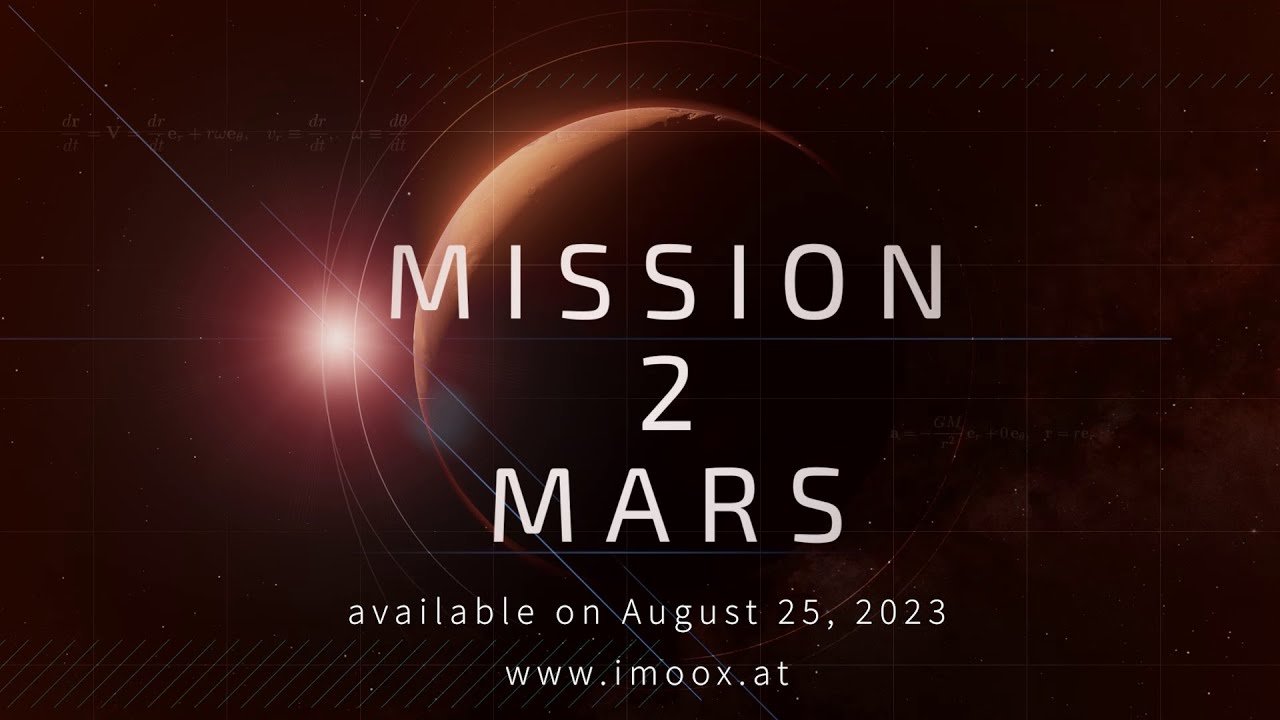Mission 2 Mars
Course start: 25. August 2023
Mission 2 Mars
Prof. Dr. Joseph Iannelli
Scientific classification:
Course start: 25. August 2023
Mission 2 Mars
Prof. Dr. Joseph Iannelli
-
Scope: 5 units
-
Effort: 2 hours/week
-
Current participants: 322
-
Licence: CC BY 4.0
-
Course start: 25. August 2023
-
Course end: -
-
Current status: Ongoing course
-
Available languages:
Trailer
Course details
General information about the course
Are you fascinated by space explorations? Would you like to understand, predict, and explain the orbits of planets and the flight of spacecraft? Did you enjoy “The Martian” film?
Then you have landed in the right spaceport. Mars has always fired people’s imagination, with questions about whether life ever existed on the Red Planet, whether our planetary neighbor could be colonized by humanity, and whether the needed technological developments to enable astronauts to land on Mars would advance economies, societies, and international cooperation here on Earth. To address these and related questions we need to understand how to fly to the Red Planet.
This “Mission 2 Mars”-MOOC illustrates the motion of planets and expounds to course attendees how they can plan, calculate, and visualize the flight of crewed and uncrewed spacecraft to Mars, based on Kepler’s three laws of planetary motion and Newton’s law of universal gravitation. Also included is the flight of a spacecraft featuring a rotating ring to provide an artificial gravity habitat for spacecraft crews on extended space missions.
Turning science fiction into science reality, the course caters to audiences with scientific backgrounds, including those with Astronomy, Mathematics, Mechanical Engineering, or Physics backgrounds. This MOOC has arisen from an upper-division semester course taught at Washington State University. The lecturer conceived the course after his students were impressed with “The Martian” film and became excited about learning the science of space flight and visualizing trajectories of spacecraft and celestial bodies
Course content
The course consists of five major components:
1. Foundations of Orbital Mechanics
2. Calculation of Travel time to Mars and Spacecraft Orbits around Earth and Mars
3. Trajectories for Departure from Earth and Arrival at Mars
4. Interplanetary Voyage from Earth to Mars
5. Dynamics of Spacecraft with Artificial Gravity Environment
Learning goals
- Comprehension of the motion of celestial bodies in outer space based on Kepler’s three laws of planetary motion, Newton’s law of universal gravitation, and Newton’s laws of dynamics
- Understanding of the governing space-flight system and representative solutions in dimensional and non-dimensional forms, including conservation of total mechanical energy and angular momentum
- Planning of missions to Mars and determination of trajectories and flight times for complete missions, including travel to Mars and return to Earth
- Acquisition of the concepts of orbital eccentricities, planetary spheres of gravitational influence, and impact of the gravitational fields of not only the Sun, but also of Earth and Mars on the flight of spacecraft to Mars
- Understanding of space-flight translational and rotational motion of crewed spacecraft with rotating toroidal components to establish artificial gravity, to preserve the health of crews on multi-month missions to Mars
Skills as learning objectives
- Ability to formulate the expressions of orbital mechanics for a specified number of celestial bodies, including the translational and rotational motion of a spacecraft
- Ability to use NASA’s Horizons online system to determine ephemerides of chosen celestial bodies to include in computational models
- Ability to use orbital-mechanics software, computationally to determine flight times as well as mission trajectories, rotational dynamics, and orbits of spacecraft and satellites
- Ability to determine flight speeds for spacecraft to escape Earth’s gravitational field, arrive within Mars’s gravitational field, and enter orbit around Mars
- Ability to understand the need for rotating toroidal components in spacecraft to establish desired levels of artificial gravity
Prerequisites
English language skills along with basic knowledge of the physics of motion and related mathematical concepts are recommended for a rewarding participation in this MOOC.
Certificate
For actively participating in the course you will receive an automatic certificate which includes your username, the course name as well as the completed lessons. We want to point out that this certificate merely confirms that the user answered at least 75% of the self-assessment questions correctly.
Licence
This work is licensed under Creative Commons - 4.0 International (CC BY 4.0) Prof. Dr. Joseph Iannelli, iMooX.at & TU Graz International Office - Welcome Center
Course instructor
Prof. Dr. Joseph Iannelli
Prof. Dr. Joseph Iannelli, Fellow, British Advance Higher Education Academy, Professor of Mechanical Engineering and Scientific Computing at Washington State University, (WSU) United States, and formerly short-term Visiting Scientist at ICOMP (Institute for Computational Mechanics in Propulsion) at NASA Glenn.
You can find more information about Prof. Iannelli on the WSU website.
Partners
-

Washington State University


